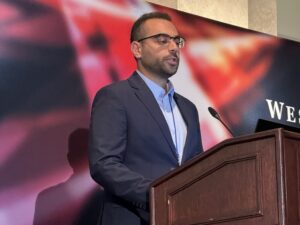
A new analysis has found arm vein to be the most suitable alternative conduit to great saphenous vein (GSV) in chronic limb-threatening ischemia (CLTI) patients, particularly in below-knee bypass targets. Prosthetic grafts also represent an adequate option, the researchers add, whilst advising that the use of biological grafts in this setting should be limited.
The research—a retrospective analysis of prospectively collected data from the Vascular Quality Initiative (VQI)—were recently published in the Journal of Vascular Surgery (JVS) following its presentation at the 2024 Western Vascular Society (WVS) annual meeting (Sept. 7–10) in Colorado Springs, Colorado.
First author Mohammed Hamouda, MD, senior author Ann C. Gaffey, MD, both from UC San Diego in San Diego, California, and colleagues write in JVS that, while the optimal conduit for infrainguinal bypass is single-segment GSV, this is not aways available in patients with CLTI. Therefore, suitable alternatives conduits are warranted.
Of the options that are available at present—arm vein grafts, prosthetic grafts, and biological grafts—Hamouda et al state that the available contemporary data regarding their durability and limb salvage rates is scarce. As a result, the researchers aimed to investigate the impact of these alternative graft types on postoperative and long-term outcomes of infrainguinal bypass in patients with CLTI.
The investigators share that they queried the VQI database for patients who underwent lower extremity bypass surgery in the last 20 years, with patients stratified into three graft groups: arm vein (cephalic/basilic), prosthetic (Dacron/polytetrafluoroethylene [PTFE]), and biological (cadaveric/homograft/xenograft).
Outlining the methodology used for the study, Hamouda and colleagues write that multivariate logistic regression analyzed postoperative outcomes including 30-day mortality, major adverse cardiovascular events (MACE), graft occlusion, prolonged length of hospital stay, and infection. Furthermore, they detail that Cox regression was used to report the one-year outcomes of mortality, major amputation (above-ankle), and major adverse limb events (MALE)—defined as major amputation, thrombectomy or reintervention.
The authors share that 9,165 infrainguinal procedures from the over 20-year study period. These included 417 arm vein grafts (4.55%), 7,520 prosthetic grafts (82.05%), and 1,228 biological grafts (13.4%).
Hamouda et al report in their results that, compared to arm vein grafts, patients receiving prosthetic grafts had higher odds of infection (adjusted odds ratio [aOR] 2.89, p=0.045) and higher hazard of one-year mortality (aOR 1.51, p=0.035).
On the other hand, the investigators continue, patients receiving biological grafts had higher risk of graft occlusion (aOR 4.55, p=0.04) and infection (aOR 2.78, p=0.046) as well as higher hazard of one-year mortality (aOR 1.53, p=0.04), amputation (aOR 1.72, p=0.019) and amputation or death (aOR 1.52, p=0.005) compared to arm vein grafts.
Finally, the authors note that, after stratifying by bypass configuration, arm vein grafts had the highest overall survival and amputation-free survival among the three alternative conduits in below-knee popliteal and tibial bypass targets.
“In this large multi-institutional study investigating alternative conduits to GSV, arm vein grafts are found to be the most resistant to infections and are associated with the best overall survival and limb salvage outcomes compared to prosthetic grafts and biological grafts, particularly in below-knee distal targets,” Hamouda and colleagues conclude.
The investigators add that, in cases where no GSV is available, both arm vein grafts and prosthetic grafts are “acceptable alternatives”. On the other hand, biological grafts are associated with a higher risk of graft occlusion and lower freedom from major amputation and death. Hamouda et al therefore advise that the use of biological grafts “should be limited to situations when other options are not available or feasible.”












